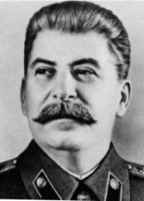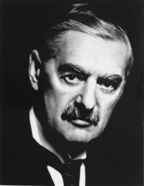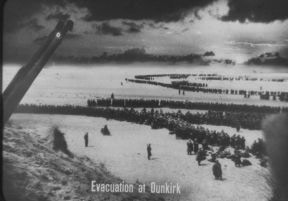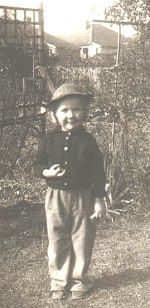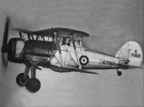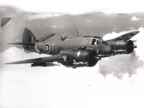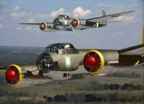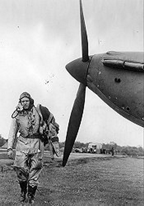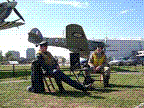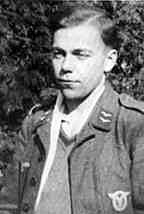Americans liked to see "Kilroy Was Here" scrawled on walls to show they were there first in World War II. The Germans might have written "Kilroy Vas Here" in America if it weren't for the Battle of Britain. Three months of Future Shock changed the war.
pilots — even if the
Germans were as young as they were. And the Germans had more combat
airplanes. Just before the battle began, the Luftwaffe had 2,600 fighters
and bombers ready. The British, 640 fighters.
In 1940, Hitler's German war machine had overrun most of Europe. Only one country stood in its way in the West: the British Isles and England, isolated and nearly helpless. The United States was staying out of the European War at that time, but Hitler had his dreams. He would get around to America in good time. At first, Hitler didn't want to invade England. He admired the Brits and their Empire, now a Commonwealth of nations. Surely the British would come to their senses and offer a peace settlement, seeing what his armies had done.
aid as a test of his new
military. His Condor Legion bombers are said to have killed 10,000
people. To simplify a complicated and fanatical war involving International
Brigades and many parties, it's enough to say the Socialists/ Communists
were the losers in Spain. The Fascists were the winners. Hitler could
hardly wait to attack the Soviet Union. Hitler made his generals very
nervous.
Parliament and its people in June.
He had nothing to offer them but "blood, toil, tears and sweat,"
yet the Brits' would fight.
For a time, it was what Americans called a "Phony War". Since war was declared in September of 1939 things were quiet at home. There were submarine sinking of ships, and a German bomber had crashed, destroying 50 houses and killing numerous civilians in England. But the "Blitzkrieg" or Lightning War that rolled across country after country didn't arrive in Britain. The Wehrmacht tanks and troops couldn't swim the English Channel. Yet. It's
a Long, Long Time On May 10, 1940, Germany attacked Belgium, Holland, Luxembourg and France. By June 18, the countries were conquered. All British forces had withdrawn from France. Perhaps to distract Hitler from gazing east, or because it was natural after the British disaster at Dunkirk, German generals began looking seriously at the idea of invading Britain. Their thinking ran like this:
"We might, had the plans been ready, have crossed to England with strong forces after the Dunkirk operation," ---General Guenther Blumentritt
in July, 1940. Plans were hastily made to do just that, and presented to an impatient Hitler by mid-July. Germany could land forces in Southern England within months. "Since England, in spite of
her hopeless military situation, shows no signs of being ready to
come to a compromise, I have decided to prepare a landing operation
against England, and, if necessary, to carry it out," Hitler
said in a general order. The man who at one stage did not want to have anything to do with an invasion of Britain was now determined that these rushed plans for ‘Operation Sea Lion' should go ahead, according to the Historical Society's chronicler. Long-Suffering Brits'
was already on a war footing. Their
list of available interception aircraft wasn't long or entirely satisfactory:
the Luftwaffe pilots got
their measure, the glory days of the Defiant were over." Incapable
of dog fighting with no front guns, the Defiant was slow and best
suited as a target. Once hit, the gun turrets were hard to get out
of. Many gunners and pilots went down with their planes. So many Defiants
were lost in the Battle of France and in the early stages of the Battle
of Britain, that "…Defiant squadrons were withdrawn to western
and northern airfields away from the main combat areas".
German air offensive began in July
of 1940. Slightly faster and much more maneuverable than its battle
rival, the German Me-109, it eventually reached over 400 mph in later
versions and was used throughout the war. Armed only with .303 machine
guns for the battle, it had no deadly cannons to match its German
rival.
Against them when the battle began were a variety of impressive German aircraft—impressive on paper.
hit could blow the tail or
wings off another aircraft. Compare that to the British standard guns--.303
caliber bullets. It was such a good aircraft the Luftwaffe used them
throughout the Second World War. Constant updating with better engines,
supercharging and combat fuel injection kept them competitive. Rumors
of weak landing gear were unfounded, though the narrow gear made landing
and taxiing difficult on rough ground. But the same could be said
of the Spitfire. Limited fuel range handicapped the Me-109 in the
Battle of Britain.
actual aircraft company.
Like the English Blenheim, the Me-110 was too slow and not maneuverable
enough against faster fighters. The Me-110 made a good fighter-bomber
when there was air superiority and no attackers. Used for escort duties
to protect bombers against English Spits' and Hurricanes, it turned
out to need protection itself. Me-109 pilots often had to rescue the
slow-turning and slow-accelerating ‘110's.
speed of 195 mph was seldom
reached except diving. Cruising speed was about 118 mph and climb
was slow. With fighter protection overhead, the Stuka was a ship killer
and Eastern Front tank buster.
Stuka and the Heinkel He-111.
Its bombs helped heap up the death toll of over 10,000 people by the
German's Condor Legion in Spain. But this slow aircraft paid the price
over England.
The Invasion Plan Once the Luftwaffe aircraft cleared the skies of British planes, an invasion of Britain could take place, code-named Operation Sea Lion. Phase One. Probing air attacks in the South of England to find any weaknesses. Draw the British interceptors out by attacking their ships in the ocean channel between England and the occupied countries of France, Belgium, Norway and the Netherlands (Holland). Shoot the Brits' down and wear down their defenses by attrition.
and so were loading docks and ships.
The Stukas would bomb not only airbases and factories, but blow out
the troublesome radar stations along the Southern Coast.
Phase Three would be the invasion. German troops, tanks and armored vehicles would cross the Channel by ship and land at places along the English coast from Dover in the east to Falmouth in the west. Like he expected the British to do later, Hitler approved of sending landing ships across from France at the narrowest spot in the Channel. Some 30,000 paratroopers would drop in first to cut lines of communication and raise general hell. Then over 100,000 Germans would storm ashore from landing craft and work their way across the country. The trouble was, the British didn't cooperate. RAF Fighter Command Air Marshall Hugh Dowding smelled out the German plan for Phase One and kept his interceptors close to home. He didn't have nearly enough fighters and couldn't afford to lose them protecting shipping. He turned down Churchill's almost begging request to help the French, and refused to send fighters when Stukas began bombing English ships tied up at the docks. Dowding said they were too far from RAF air bases. Churchill called the RAF fighter pilots "Dowding's Chicks". The name stuck for the old mother hen's flyers. The Pilots
radar. The Stukas bombed
the radar stations as well as the bases. But the radar towers were
easy to put back up and the Stukas weren't. The "terror weapon"
Stukas turned out to be easy targets for good fighters.
The movie image of dashing British Royal Air Force pilots from the highest levels of society tearing around in their sports cars before tearing up German aircraft isn't entirely wrong. "601 Squadron had a number of these, and the parking lot at Tangmere (airbase) used to look like a starting point for a 'concours de elegance' with brightly coloured MG's and Austin Healey's looking in far better shape than the Hurricanes that they flew," the Historical Society author wrote. About 3,500 RAF pilots took part in the Battle of Britain as pilots were killed and replaced. About 200 had a public school education. Most were bank clerks, farm boys, factory workers, shop assistants and hundreds of young men who had just ordinary jobs. "We were all amateurs. Yet the young pilots lived their lives to the full because they knew that any day they'd be dead." --Gregory Kirkorian. RAF Squadron Intelligence
""Look, you've got to face it, France was a shambles. Everyone tried their best, but most of us pilots were not only new to flying in combat, we were new to flying in general." --- Sgt G.C. Bennett, 609 Squadron. (Later killed in 1941)
Bennett described combat: The Other Pilots What was it like on the other side of the Swastika? Hitler had taken a discouraged, mauled, losing nation in deep financial and emotional depression after the "Great War"—now called the First World War—and pulled his country up by its bootstraps. With a little help from investors, including some U.S. businessmen, he got industry working again and stopped the growing starvation. No wonder he was popular with the German people. The street kids he put into "Youth Groups." The military he woke up. The population perked up and elected him Chancellor of Germany in 1933. That his brutal NAZIonal Socialist Party "brownshirts" used a great deal of violence was only a prelude to the violence he planned against Jews and other racially inferior types. Which happened to include many people living in other nations near Germany.
"We were idealists with the honor of being part of the most elite fighting force in the world, " a young cadet said about his graduation day. Hitler gave the commencement address to 3,000 new Luftwaffe recruits."...We listen to the spell-binding words of our leader and accept them with all our hearts. Never before have we experienced such a deep sense of patriotic devotion towards our beloved German fatherland. I shall never, never forget the expressions of rapture which I saw on the faces around me..."
would not have made." Bruno
escaped with his life, chased by two Spitfires "shooting occasionally"
until he crash landed his Me-109.
The English .303 caliber bullets had a hard time bringing down ‘109's, but were enough to bring down the dive-bomber Stukas. The terror of the skies turned out to be slow and clumsy when they weren't diving to drop their bombs. Stuka attacks quickly dwindled and the "terrors" were soon given other work. The small-caliber bullets had enough hitting power to drop the also-slow twin-engine Me-110 fighters. And the British bullets damaged or destroyed the Luftwaffe's medium bombers. Part wood Hurricanes were inferior fighters to the Me-109's, but shot down many German fighters anyway. Hurricanes could take a lot of damage. Hurricane pilots proved braver and smarter than expected, and sent a lot of German aircraft out of the sky. The RAF's "sport plane" Spitfire was chief defense against the superior German fighters. The Spit' could out-turn the Me-109 if not out-climb or out-dive it, and proved a worthy opponent despite some problems. The Spit's carburetor would cut out during aerobatics, something the German pilots quickly noticed and took advantage of. Their own planes were fuel-injected and didn't have that problem. Nevertheless, the Spitfire with its graceful wings became the symbol of British resistance, even if the dogged workhorse Hurricane brought down far more of the enemy. The Spit' was updated with cannons, fuel injection, and more powerful Rolls-Royce engines. Eventually, when Luftwaffe chief Goering asked the great "experten" pilot Adolph Galland what he needed to stop the British, his answer was "Spitfires". Destruction and damage to English airfields brought the RAF to the edge of desperation. Phase Two of the German plan would have succeeded in a few more weeks of bombing by the Luftwaffe in 1940. Soon their aircraft would have been forced into long-distance interception just as German planners wanted. Enter the hand of fate. A German bomber crew in trouble had to rid themselves of their bomb load and accidentally dropped them on London, despite Hitler's stern orders not to hit the English population.It was a psychological blow. English Prime Minister Winston Churchill answered it by ordering a night bomber raid against Berlin. Goering had sworn German cities would not be bombed. But it was tit for tat, and the Brits' got a great lift of spirit, as Americans did when Jimmy Doolittle's B-25's took off from an aircraft carrier and bombed Japan after Pearl Harbor. It was a change in tactics just in time to save the RAF airfields. Victory Phase Three turned out not to be an invasion, but the German bombing "Blitz"of cities like Portsmouth, Somerset, Coventry, Liverpool, Preston, South Wales and especially the capital of London. The lives lost by civilians saved the RAF---and their nation. By September 17, Hitler's invasion date, the Battle of Britain was effectively won. More German craft than British were lost that day and every day. Air superiority was out of reach. Hitler postponed "Operation Sea Lion" indefinitely. He turned east to the Soviet Union. The war wasn't over though the battle really ended by mid-October. A careful check of records on both sides show 1,733 German aircraft were lost, and 915 British planes downed in those three months of the Battle of Britain. About half of what either side publicly claimed. It wasn't just propaganda. Two fighters shooting at one aircraft might each claim a victory. Gun cameras weren't added for movie entertainment, but to keep track of such things. The flying and fighting continued. RAF pilots, who included seven Americans, kept busy night-fighting the Blitz after the daylight raids proved too costly for the Luftwaffe. The searchlights would find the bombers or fighters, or radar would on some aircraft. Even the slow Blenheims got five in one night. British aircraft companies kept busy bringing new and more capable aircraft to the fighting front. The deHavilland Mosquito, also made mostly of molded plywood for easy production in British wood shops and factories, had twin Rolls-Royce engines. It showed up for service a year later. The "Mossie" was as fast as a fighter, and was used as one, as well as a fighter-bomber for ground support, reconnaissance, and every other conceivable function. Later, when Germany's aircraft factories were heavily bombed, their engineers openly envied the easy-to-construct Mossie, "which any piano-maker could build".
England became an island fortress instead of being
invaded, a staging area for Allied troops and military equipment.
The troops included the vast U.S. forces that plunged together with
their friends back across the Channel and invaded Nazi-held Europe
on D-Day, 1944.
The summer and fall of 1940 made the difference. The years that followed confirmed its importance. What might have happened if Germany had conquered England? The Many do owe their thanks to the Few for what they accomplished in the Battle of Britain. ---------------- End ----------------
|
|
Visitors since
June 6, 2000 |


